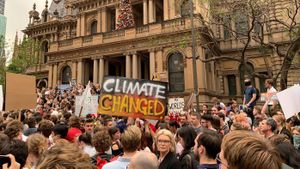Pollution levels have reached alarming heights across the Delhi-National Capital Region (NCR), leading educational institutes to take significant measures to protect students amid deteriorated air quality. With the city's Air Quality Index (AQI) previously hitting roughly 460, categorized as 'severe plus,' both state and educational authorities have prioritized health and safety over traditional learning methods. This pressing issue has forced many schools and universities to transition to online classes effective November 20, 2024.
The directive first came from major universities, including Jawaharlal Nehru University (JNU) and Jamia Millia Islamia, who suspended physical classes through November 23. They established online classes to have students continue their studies without exposing them to unhealthy air quality. JNU and Jamia Millia announced this move just after the Supreme Court mandated the closure of schools for all students, effective until classes for class 12. The health risks posed by such pollution have been understood universally, prompting educational bodies to take swift action.
Jamia Millia Islamia's official notification explicitly stated: "The university’s administration directed the heads of all schools to suspend physical classes until the situation improves, prioritizing the health and well-being of students." While the authorities reacted quickly, academic schedules for examinations and interviews remain unchanged, streamlining digital education without complications to assessment timelines.
Delhi University followed suit, also suspending physical classes until November 23, after which traditional learning is hoped to resume. The official notifications conveyed the universities' commitment to ensuring educational continuity through disaster management measures. Local authorities indicate it's not only students who are feeling the pinch; the current air quality crisis has prompted community evacuations throughout the region. Many families are reportedly leaving the NCR temporarily to escape health risks posed by air pollution.
Further south, the Khairthal-Tijara district administration of Rajasthan characterized by its recent reorganization, has also taken this as an opportunity to shift to online schooling for lower grades. Here, officials clarified the measure affects both government and private institutions accommodating students from grades 1 to 5 and is set to last from November 20 through November 23. The District Collector, Kishore Kumar, emphasized this decision was taken under the recommendations of the Supreme Court to prioritize pupils’ health.
Compared to previous instances where air quality crises turned volatile during Delhi’s winter months, the 2024 scenario has demonstrated immediate repercussions on the education sector. Observations show the immediate impacts of previous pollution spike emergencies only made themselves apparent weeks down the line. The situation seems different this time as universities and smaller educational institutions are quick to safeguard students from health hazards.
While some schools across Delhi-NCR are pushing forward with online education solutions, the overarching crisis provides both challenges and opportunities for educational stakeholders. Digital platforms have been increasingly used, and schools have adapted to new learning strategies quickly, recognizing the need to maintain curriculum continuity.
State educational boards express ways to leverage technology effectively to counteract pandemic-era challenges faced previously, now broadening to encompass health emergencies. With Jammu and Kashmir, and even UP, previously managing schools optimally has changed how education will mold among youth.
Chief Minister Atishi took to social media platform X, declaring: "Physical classes for Class 10 and 12 will also be suspended starting November 19, shifting all studies to online platforms accordingly." This statement emphasizes the urgency of the crisis and reflects the response of local authorities on the ground.
This digital shift could change the educational environment for students, as those transitioning to virtual learning could gain skills directly connected to current trends, enhancing engagement. While there are apprehensive feelings about this shift, educators believe balanced approaches can mitigate academic fallout.
The growing trend of online classes highlights both the resources needed and efforts being taken to promote educational resilience. Digital tools empower educators to provide support even within health crises as they advance with their instructional strategies, assuring the education system remains steady amid turbulence.
With weather forecasts indicating fluctuated conditions throughout the winter, including increased smog presentations, residents across the capital are advised to remain vigilant and reduce outings to maintain health. Last-minute adaptations and precautions encourage families to review strategies for managing interactions effectively.
While air quality levels remain underrated, authorities are continuously monitoring the situation—providing schools necessary updates should changes occur. Authorities have assured citizens of their commitment to monitoring air quality levels, emphasizing educational responsiveness amid deteriorated conditions. Support from community-centric programs will also be available, steering students toward wellness and responsible options for staying engaged during the transition to digital classrooms as health priority intersects thoroughly with education effectiveness.
On one hand, legislative powers mandated responses will be influencing future instances of crisis management, with educational institutes actively debating plans for fostering educational continuity, creating norms for transitioning swiftly during unforeseen times depending on health initiatives. On the opposite end, students remind observers how urgent it is to safeguard academic longevity and growth, irrespective of environmental obstacles. The full extent of these changes marks considerable shifts for the education sector—digitization may become more permanent as air quality remains inconsistent, warranting institutional readiness for challenges arising from environmental impacts.



